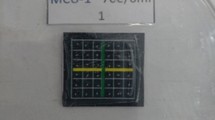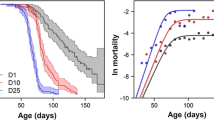Abstract
Changing reproductive strategy from investment in current (asexual eggs) to future (sexual ephippia) reproduction depending on environmental cues is an important fitness trait in zooplankton species like water fleas, Daphnia. Different cues are reported for ephippia production, for example food limitation, changes in photoperiod and temperature, the presence of predators, nutrient depletion or signals of crowding. However, the reliability of these cues strongly depends on the local habitat. In Daphnia galeata, ephippia production might not be subject to any of the environmental cues outlined. Here, we directly test whether changes in crowding alone provides a reliable cue for D. galeata to switch reproductive mode. We conducted life history assays using 10 genotypes of D. galeata from a Swiss Lake to investigate density dependent reproduction and production of ephippia. We started populations at different densities and eliminated competition for food by systematically increasing food availability with population size. Our results suggest that population density depresses population growth rate via a change in energy allocation from current into future reproduction in D. galeata. Thus, signals of crowding produced at high population density constitute a reliable and sufficient cue for D. galeata to switch from asexual to sexual reproduction.




Similar content being viewed by others
Data availability
All data and processing scripts used in this study will be available on github/lhaltiner.
References
Auld, S. K. J. R., S. K. Tinkler & M. C. Tinsley, 2016. Sex as a strategy against rapidly evolving parasites. Proceedings of the Royal Society B: Biological Sciences 283: 20162226.
AWEL Kanton Zürich Switzerland, 2019. Depth profiles Greifensee. [available on internet at https://awel.zh.ch/internet/baudirektion/awel/de/wasser/messdaten/see_qualitaet.html].
Begon, M., J. L. Harper & C. R. Townsend, 1986. Ecology: Individuals, Populations and Communities. Blackwell, Oxford.
Benzie, J. A. H., 2005. The Genus Daphnia (Including Daphniopsis)(Anomopoda: Daphniidae). Kenobi Productions, Backhuys Publishers, Ghent, Leiden.
Bittner, K., K. O. Rothhaupt & D. Ebert, 2002. Ecological interactions of the microparasite Caullerya mesnili and its host Daphnia galeata. Limnology and Oceanography 47: 300–305.
Black, A. R. & S. I. Dodson, 2003. Ethanol: a better preservation technique for Daphnia. Limnology and Oceanography: Methods 1: 45–50.
Boersma, M., P. Spaak & L. De Meester, 1998. Predator-mediated plasticity in morphology, life history, and behavior of Daphnia: the uncoupling of responses. The American Naturalist 152: 237–248.
Booksmythe, I., N. Gerber, D. Ebert & H. Kokko, 2018. Daphnia females adjust sex allocation in response to current sex ratio and density. Ecology Letters 21: 629–637.
Brede, N., C. Sandrock, D. Straile, P. Spaak, T. Jankowski, B. Streit & K. Schwenk, 2009. The impact of human-made ecological changes on the genetic architecture of Daphnia species. Proceedings of the National Academy of Sciences 106: 4758–4763.
Brooks, M. E., K. Kristensen, K. J. van Bethem, A. Magnusson, C. W. Berg, A. Nielsen, H. J. Skaug, M. Maechler & B. M. Bolker, 2017. glmmTMB balances speed and flexibility among packages for zero-inflated generalized linear mixed modeling. The R Journal 9: 378–400.
Burns, C. W., 1969. Particle size and sedimentation in the feeding behavior of two species of Daphnia. Limnology and Oceanography 14: 392–402.
Cáceres, C. E., 1998. Interspecific variation in the abundance, production, and emergence of Daphnia diapausing eggs. Ecology 79: 1699–1710.
Cleuvers, M., B. Goser & H. Ratte, 1997. Life-strategy shift by intraspecific interaction in Daphnia magna: change in reproduction from quantitiy to quality. Oecologia 110: 337–345.
Deng, H. W., 1996. Environmental and genetic control of sexual reproduction in Daphnia. Heredity 76: 449–458.
Ebert, D., 1995. The ecological interactions between a microsporidian parasite and its host Daphnia magna. The Journal of Animal Ecology 64: 361–369.
Edmondson, W. T., 1960. Reproductive rates of rotifers in natural populations. Memorie dell’Istituto Italiano di Idrobiologia 12: 21–77.
Friedman, M., 1937. The use of ranks to avoid the assumption of normality implicit in analysis of variance. Journal of the American Statistical Association 32: 675–701.
Gerber, N., H. Kokko, D. Ebert & I. Booksmythe, 2018. Daphnia invest in sexual reproduction when its relative costs are reduced. Proceedings of the Royal Society B: Biological Sciences 285: 20172176.
Guillard, R. R. L., 1975. Culture of phyoplankton for feeding marine invertebrates. In Smith, W. L. & M. H. Chantey (eds), Culture Marine Invertebrate Animals. Springer, Boston: 29–60.
Hobaek, A. & P. Larsson, 1990. Sex determination in Daphnia magna. Ecology 71: 2255–2268.
Jankowski, T. & D. Straile, 2003. A comparison of egg-bank and long-term plankton dynamics of two Daphnia species, D. hyalina and D. galeata: potentials and limits of reconstruction. Limnology and Oceanography 48: 1948–1955.
Jarnagin, T. S., B. K. Swan & C. W. Kerfoot, 2000. Fish as vectors in the dispersal of Bythotrephes cederstroemi: diapausing eggs survive passage through the gut. Freshwater Biology 43: 579–589.
Karabanov, D. P., E. I. Bekker, R. J. Shiel & A. A. Kotov, 2018. Invasion of a Holarctic planktonic cladoceran Daphnia galeata Sars (Crustacea: Cladocera) in the Lower Lakes of South Australia. Zootaxa 4402: 136–148.
Keller, B., H. R. Bürgi, M. Sturm & P. Spaak, 2002. Ephippia and Daphnia abundances under changing trophic conditions. Verhandlungen, Internationale Vereinigung für Theoretische und Angewandte Limnologie 28: 851–855.
Keller, B., J. Wolinska, C. Tellenbach & P. Spaak, 2007. Reproductive isolation keeps hybridizing Daphnia species distinct. Limnology and Oceanography 52: 984–991.
Kerfoot, W. C., J. A. Robbins & L. J. Weider, 1999. A new approach to historical reconstruction: combining descriptive and experimental paleolimnology. Limnology and Oceanography 44: 1232–1247.
Kleiven, O. T., P. Larsson & A. Hobaek, 1992. Sexual reproduction in Daphnia magna requires three stimuli. Oikos 65: 197–206.
Lampert, W., 1987. Feeding and nutrition in Daphnia. In De Bernardi, R. & R. H. Peters (eds), Daphnia. Memorie dell’Istituto Italiano di Idrobiologia, Verbania Pallanza: 143–192.
Lampert, W., 2011. Daphnia: Development of a Model Organism in Ecology and Evolution. Excellence in Ecology Series International Ecology Institute. Oldendorf/Luhe Book, Lübeck: 21.
Lass, S. & P. Spaak, 2003. Chemically induced anti-predator defences in plankton: a review. Hydrobiologia 491: 221–239.
Lehtonen, J., M. D. Jennions & H. Kokko, 2012. The many costs of sex. Trends in Ecology and Evolution 27: 172–178.
Levene, H., 1960. Robust tests for equaltiy of variances. In Olkin, I. (ed.), Contributions to Probability and Statistics. Stanford University Press, Palo Alto: 278–292.
Lively, C. M. & R. S. Howard, 1994. Selection by parasites for clonal diversity and mixed mating. Philosophical Transactions - Royal Society of London, B 346: 271–281.
Lynch, M., 1983. Ecological genetics of Daphnia pulex. Evolution 37: 358–374.
Lynch, M., 1984. The limits to life history evolution in Daphnia. Evolution 38: 465–482.
Miner, B. E., L. De Meester, M. E. Pfrender, W. Lampert & N. G. Hairston, 2012. Linking genes to communities and ecosystems: Daphnia as an ecogenomic model. Proceedings of the Royal Society B: Biological Sciences 279: 1873–1882.
Möst, M., A. C. Chiaia-Hernandez, M. P. Frey, J. Hollender & P. Spaak, 2015. A mixture of environmental organic contaminants in lake sediments affects hatching from Daphnia resting eggs. Environmental Toxicology and Chemistry 34: 338–345.
Pijanowska, J. & G. Stolpe, 1996. Summer diapause in Daphnia as a reaction to the presence of fish. Journal of Plankton Research 18: 1407–1412.
R Core Team, 2017. R: a language and environment for statistical computing. R Foundation for statisical computing. Vienna, Austria, [available on internet at https://www.r-project.org/].
Rellstab, C., B. Keller, S. Girardclos, F. S. Anselmetti & P. Spaak, 2011. Anthropogenic eutrophication shapes the past and present taxonomic composition of hybridizing Daphnia in unproductive lakes. Limnology and Oceanography 56: 292–302.
Roulin, A. C., J. Routtu, M. D. Hall, T. Janicke, I. Colson, C. R. Haag & D. Ebert, 2013. Local adaptation of sex induction in a facultative sexual crustacean: insights from QTL map** and natural populations of Daphnia magna. Molecular Ecology 22: 3567–3579.
Roulin, A. C., Y. Bourgeois, U. Stiefel, J. C. Walser & D. Ebert, 2016. A photoreceptor contributes to the natural variation of diapause induction in Daphnia manga. Molecular Biology and Evolution 33: 3194–3204.
Schurko, A. M., J. M. Logsdon & B. D. Eads, 2009. Meiosis genes in Daphnia pulex and the role of parthenogenesis in genome evolution. BMC Evolutionary Biology 9: 1–27.
Shapiro, S. S. & M. B. Wilk, 1965. An analysis of variance test for normality (complete samples). Biometrika 52: 591–611.
Sibly, R. M., T. D. Williams & M. B. Jones, 2000. How environmental stress affects density dependence and carrying capacity in a marine copepod. Journal of Applied Ecology 37: 388–397.
Sommer, U., Z. M. Gliwicz, W. Lampert & A. Duncan, 1986. The PEG-model of seasonal succession of planktonic events in fresh waters. Archiv für Hydrobiologie 106: 433–471.
Sommer, U., R. Adrian, L. D. S. Domis, J. J. Elser, U. Gaedke, B. Ibelings, E. Jeppesen, M. Lürling, J. C. Molinero, M. Wolf, E. Van Donk, M. Winder, U. Sommer, R. Adrian, L. D. S. Domis, J. J. Elser, U. Gaedke, B. Ibelings, E. Jeppesen, M. Lürling, J. C. Molinero, W. M. Mooij, E. Van Donk & M. Winder, 2012. Beyond the plankton ecology group (PEG) model: mechanisms diriving plankton succession. Annual Review of Ecology, Evolution, and Systematics 43: 429–448.
Soper, D. M., K. C. King, D. Vergara & C. M. Lively, 2014. Exposure to parasites increases promiscuity in a freshwater snail. Biology Letters 10: 3–6.
Spaak, P., 1995. Sexual reproduction in Daphnia: interspecific differences in a hybrid species complex. Oecologia 104: 501–507.
Spitze, K., 1991. Chaoborus predation and life-history evolution in Daphnia pulex: temporal pattern of population diversity, fitness, and mean life history. Evolution 45: 82–92.
Stearns, S. C., 1989. Evolution in life-history. Functional Ecology 3: 259–268.
Stross, R. G. & J. C. Hill, 1965. Diapause induction in Daphnia requires two stimuli. Science 150: 1462–1464.
Taylor, D. J. & P. D. N. Hebert, 1993. Cryptic intercontinental hybridization in Daphnia (Crustacea): the ghost of introductions past. Proceedings of the Royal Society B: Biological Sciences 254: 163–168.
Walsh, M. R., 2013. The link between environmental variation and evolutionary shifts in dormancy in zooplankton. Integrative and Comparative Biology 53: 713–722.
Woltereck, R., 1911. Aus dem Zoolog. Institut Leipzig und der Biolog. Station Lunz (XI. Beitrag). Über Veränderung der Sexualität bei Daphniden. Experimentelle Untersuchungen über die Ursachen der Geschlechtsbestimmung. Internationale Revue der gesamten Hydrobiologie und Hydrographie 4: 91–128.
Zaffagnini, F., 1987. Reproduction in Daphnia. Memorie dell’Istituto Italiano di Idrobiologia 45: 245–284.
Acknowledgements
We thank Christine Dambone and Esther Keller for support in Daphnia and algae culturing, and Nelson Stevens and Robert Dünner for statistical help. This manuscript was improved by the valuable input of two anonymous reviewers. This work was supported in part by the grant “SeeWandel: Life in Lake Constance - the past, present and future” within the framework of the Interreg V programme “Alpenrhein-Bodensee-Hochrhein (Germany/Austria/Switzerland/Liechtenstein)” which funds are provided by the European Regional Development Fund as well as the Swiss Confederation and cantons.
Author information
Authors and Affiliations
Corresponding author
Additional information
Publisher's Note
Springer Nature remains neutral with regard to jurisdictional claims in published maps and institutional affiliations.
Guest editors: Koen Martens, Sidinei M. Thomaz, Diego Fontaneto & Luigi Naselli-Flores / Emerging Trends in Aquatic Ecology III
Electronic supplementary material
Below is the link to the electronic supplementary material.
Rights and permissions
About this article
Cite this article
Haltiner, L., Hänggi, C., Spaak, P. et al. Sex in crowded places: population density regulates reproductive strategy. Hydrobiologia 847, 1727–1738 (2020). https://doi.org/10.1007/s10750-019-04143-7
Received:
Revised:
Accepted:
Published:
Issue Date:
DOI: https://doi.org/10.1007/s10750-019-04143-7




